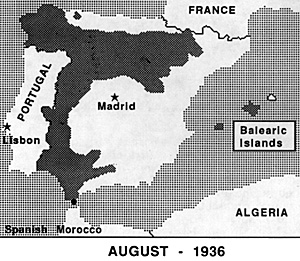
Initially the Nationalist leadership was hesitant to call up large numbers of draftees, even though the system for doing so was in place; instead, it preferred to rely on the political militias for expansion. These were mainly from two groups, the militia of the Spanish Fascist party, the Falange, and the ultra- conservative monarchists known as the Requetes. But by October 1936, the realities of fighting a civil war overcame the General's mistrust of the Spanish working class, and the drafts of 1931 to 1936 were called up, producing 350,000 recruits.
After that, the Nationalists called up draftees on a regular basis. Ultimately, around 800,000 men were drafted into Franco's army during the war.
By March 1939, the Nationalist Army had grown to a large force by any standards, with about 840,000 infantry, 15,500 cavalry, 19,000 artillery, 15,000 engineers, 35,000 colonial troops, 32,000 Italian allies and 68,000 service personnel. This vast mass was organized into eighteen army corps, with 58 infantry divisions, two cavalry divisions, and numerous independent formations, a force larger than the French army at that time. Most of the new Nationalist army had been formed by the expansion of old pre-war regular units, the new battalions taking the name of the parent unit with the appropriate number (i.e., IX Tabor de Melilla, 26 de Cueta, etc.) A smaller part of the new army was made up of political militias, mostly volunteers. Large units were formed from existing formations also. For example, the 8th division became the Vill Corp and formed the 81st, 82nd, 83rd, 84th and 85th divisions.
There was no permanent regimental organization in the Nationalist Army, the basic unit being a battalion-sized unit. These had different titles and organizations depending on the unit. Army units were called batallones and had five companies, four rifle and one machine gun, and a heavy weapons platoon. Foreign Legion banderas and colonial tabores had three rifle companies and a combined heavy weapons company. The militia's batallion-type units were called banderas, if Falangist, or tercios, if Requete, and they had no set organization. The term tercio causes some confusion inasmuch as Foreign Legion banderas were organized into regimentsized units that were also called "tercios." Moreover, the term tercio was used to refer to the Foreign Legion as a whole and to the Italian contingent in the early days of its commitment to Spain.
The rebels took some time to begin to form their forces into large units capable of fighting a real civil war. Early in the war, four to six battalions were thrown together in columns; later, brigades with territorial names were formed (i.e., 20 Avila, Caceres, Movil) After a brief period, these became de facto divisions of 8 to 14 battalions and 1 to 3 artillery grupos. As time passed, engineer, signal, and sometimes antitank companies were added. The Nationalist division structure was not standardized until March 1938, theoretically at three temporary regiments (usually named after their commanders), each with four battalions and an artillery regiment. In actuality, many divisions were larger, 16 to 18 battalions was not uncommon. Nationalist divisions were very heterogeneous in their makeup: battalions of the army, the Foreign Legion, Regulares, Falangist militia, Requetes, Marines, dismounted cavalry, and Mehal'la were all thrown together indiscriminately. The Brigadas de Navarra was an exception: they were made up almost entirely of Requetes.
Of course, assault divisions had a larger proportion of higher quality troops. The Civil Guard and other police units were used as rear-area security, not as combat troops as in the Republican army.
One unusual aspect of Nationalist army organization: Nationalist units were often much larger than their titles suggest. For example, the 6th Division in March 1937 had 60 battalions. Brigades were very often twelve or more battalions strong. This is to some extent a function of the way in which the Nationalist army expanded, building from pre-war units. It also has something to do with the character of the revolt, an uprising of middleranked officers. At the end of the war, the Nationalist army had ten times as many troops as the preJuly 1936 army, but slightly over half as many generals.
Franco's Armed Forces Spanish Civil War
Back to Europa Number 14 Table of Contents
Back to Europa List of Issues
Back to MagWeb Master Magazine List
© Copyright 1990 by GR/D
This article appears in MagWeb (Magazine Web) on the Internet World Wide Web. Other military history articles and gaming articles are available at http://www.magweb.com